Base de données des minéraux luminescents
ZIRCON
Formule chimique: ZrSiO4
Famille: Silicates
Statut: IMA-GP
Système cristallin : Quadratique
Minéral de vitrine: OUI
Noms associés (variétés luminescentes, noms discrédités, synonymes etc.): alvite, cyrtolite, malacon,
Luminescence:
Couleurs UV longs (365nm): |
Jaune pâle , Brunatre , Jaunâtre , | ||
Intensité OL:Faible | |||
Couleurs UV moyens (320nm): |
Jaune-orange , | ||
Intensité OM:Moyenne | |||
Couleurs UV courts (254nm): |
Jaune-orange , Blanc jaunâtre (crème) , Jaune pâle , Jaune , Orange brunâtre , Brunatre , Verdâtre , Jaunâtre , | ||
Intensité OC:Forte | Fréquence OC:Souvent | ||
Photo en lumière du jour
Photo Ondes Courtes (254nm)
Vous avez une photo de ce minéral que vous voudriez voir figurer dans la galerie? Contactez-nous!
Phosphorescence (au sens commun du terme) observable à l'oeil nu:
Pas de données
Ténébrescence: OUI

Thermoluminescence: OUI
Commentaires:
Variété alvite (contenant du Hf, Th et des terres rares: OC et LW: vert; SW: Rouge-orangé;
Variété cyrtolite (zircon partiellement métamicte contenant U et souvent Th et des terres rares: OC: jaune;
variété malacon (zircon très métamicte, souvent brun: OL: orange;
Le Zircon est parfois thermoluminescent et ténébrescent (Zircon bleu de qualité joaillerie devenant gris brun par irradiation aux UV longs (phénomène réversible à la lumière solaire))
Activateur(s) et spectre(s):
Activateur(s): Centres dûs aux effets des radiations, (UO2)2+ (ion Uranyle) en impureté, Cr3+, Fe3+, Sm3+, Eu3+, Dy3+, Ho3+, Er3+, Tb3+, Nd3+, Yb3+, Tm3+,
Pics dans le spectre (nm):
Dy3+ : 472, 481, 486nm (UO2)2+ : 506, 523, 550nm Fe3+ : 750 nm, Δ = 110–120 nm and τ = 3–5 ms Neutron and alpha irradiation : 575 nm, peak half-width (Δ) = 120–130 nm, and decay time (τ) = 30–35 µs
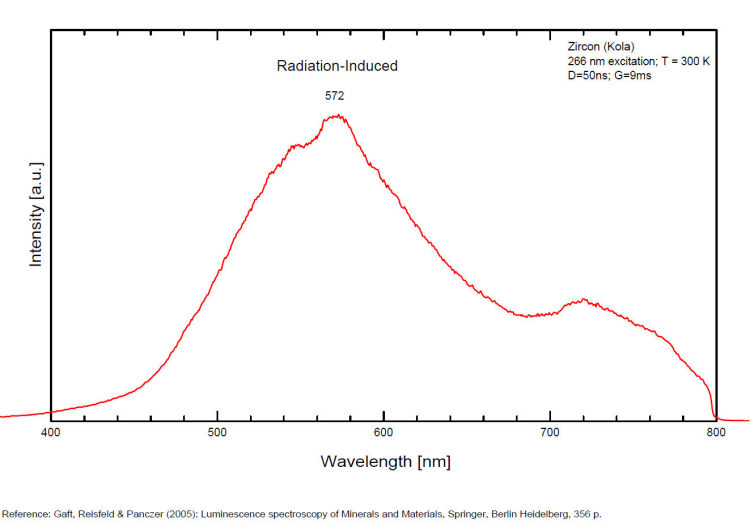
Spectrum: Michael Gaft, Petah Tikva, Israel. Plot: Institute of Mineralogy, University of Vienna, Austria, with permission of the authors.
Galerie de spectres:
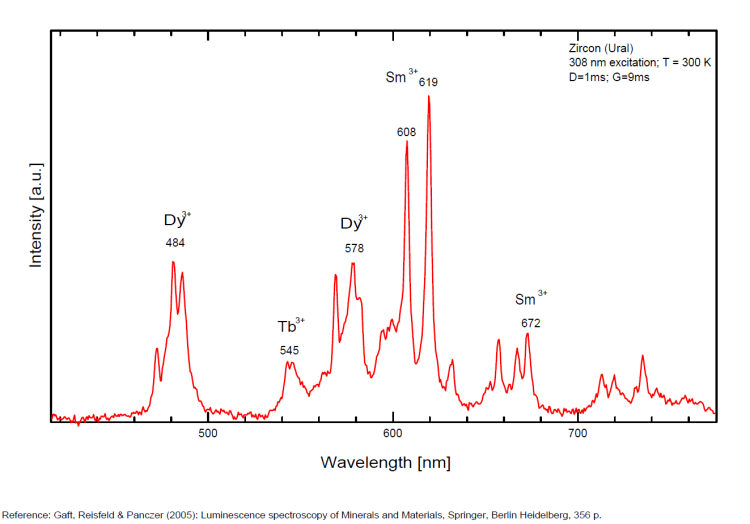
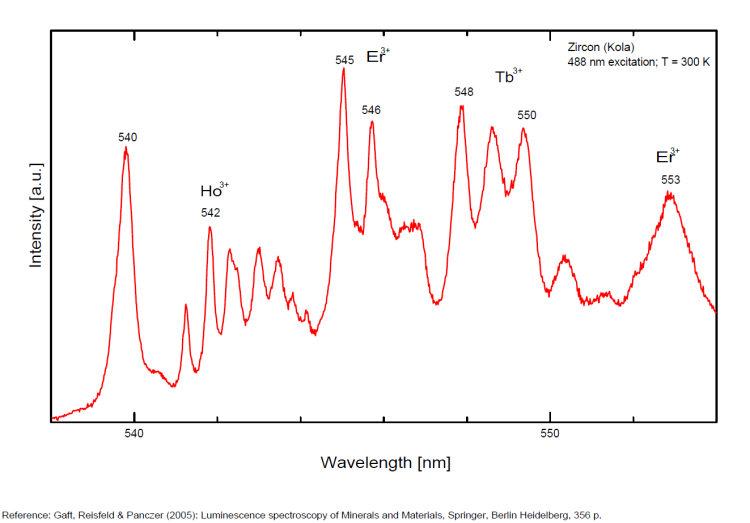
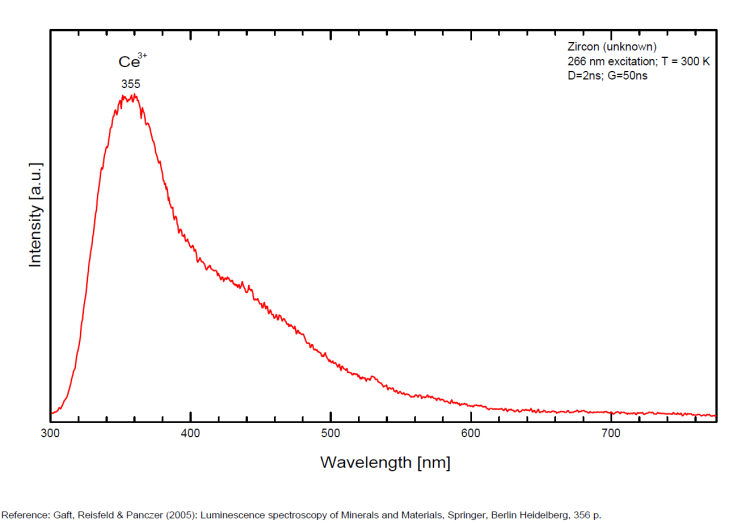
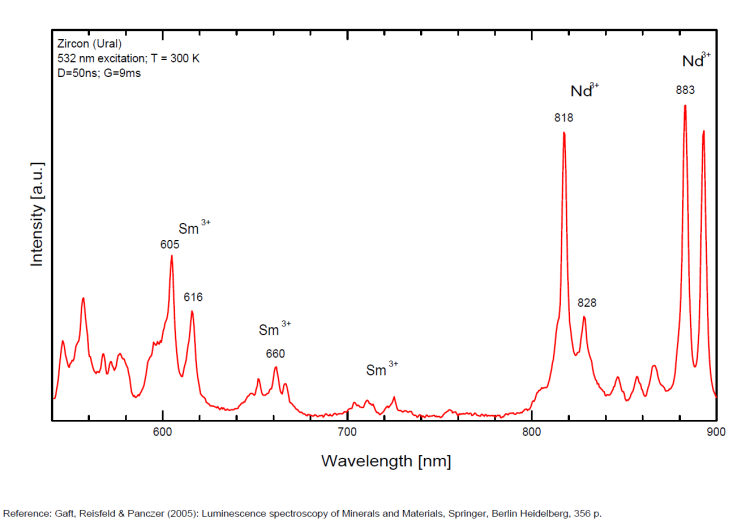 ...
...  Accès à la galerie complète (13 images au total)
Accès à la galerie complète (13 images au total)
Commentaires sur les spectres et les activateurs (*):
The crystal chemistry of zircon strongly favors the incorporation of REE in Zr4+ site. The REE impurities become luminescent in this crystallographic environment. The steady-state luminescence in natural zircons is dominated by broad emission arising from radiation induced centers and narrow emission lines of Dy3+ (Trofimov 1962; Tarashchan 1978). These emissions obscure the spectra of other REE. The thermal treatment enables to solve this problem in certain cases using the fact that the intensity of broad band luminescence quickly decreases after heating at 700 °C–800 °C, while the intensities of the REE lines remain nearly constant (Shinno 1986, 1987). Even after heating the samples not all the REE can be identified by steady-state spectroscopy since the weaker luminescence lines of certain REE are obscured by stronger luminescence of others. For example, the luminescence of Pr3+ is difficult to detect because the lines of Sm3+, Dy3+ and Nd3+ hide its radiative transitions. In turn, Tb3+ conceals luminescence of Tm3+ and so on. Different suppositions are made in previous studies and even the question about yellow luminescence connection with intrinsic or impurity defect remains open. The yellow band with peak wavelength (λmax) = 575 nm, peak half-width (Δ) = 120–130 nm, and decay time (τ) = 30–35 µs is connected with neutron and alpha irradiation. Activators: broadband emission from radiation induced centers and lines from Dy3+ (Trofimov in Gaft) masking other lines from REE in Zr4+ site.
The red band with λmax = 750 nm, Δ = 110–120 nm and τ = 3–5 ms is connected with Fe3+. (M. Gaft, I. Shinno, G. Panczer and R. Reisfeld, Laser-induced time-resolved spectroscopy of visible broad luminescence bands in zircon, Mineralogy and Petrology, vol76, 2002)
The intensity of the broadband luminescence quickly decrease after heating at 700-800° while the lines from REE stay constant (Shinno in Gaft).
(*)Les commentaires sur les spectres sont uniquement rédigés en Anglais
Meilleure(s) localité(s) pour la fluorescence (*):
- OstSkogen Quarry, Tuften Quarry, Arent Quarry, Tvedalen, Langesundfjord, Larvik Plutonic complex, Larvik, Vestfold, Norway;
- Zirconium prospect, Stokkøya, Langesundsfjorden, Larvik, Vestfold, Norway;
- Granit Quarry, Tuften, Tvedalen, Larvik, Vestfold, Norway;
- Store Kufjord, Seiland Island, Alta, Finnmark, Norway;
- Goiás, Brazil;
- Peixe, Peixe alkaline complex, Tocantins, Brazil;
- Kipawa alkaline complex, Les Lacs-du-Témiscamingue, Témiscamingue RCM, Abitibi-Témiscamingue, Québec, Canada;
- Mount Malosa, Zomba District, Malawi;
- Lovozero Massif, Kola Peninsula, Murmanskaja Oblast, Northern Region, Russia;
- Chelyabinsk Oblast, Southern Urals, Urals Region, Russia;
- Astor Valley, Astor District, Gilgit-Baltistan, Pakistan;
- Poudrette quarry, Mont Saint-Hilaire, La Vallée-du-Richelieu RCM, Montérégie, Québec, Canada;
- Mud Tank, Alcoota Station, Central Desert Region, Northern Territory, Australia;
(*)Les données ne sont pas exhaustives et sont limitées à quelques localités remarquables pour la fluorescence
Référence bibliographique pour la luminescence:
- The Henkel Glossary of Fluorescent Minerals, Dr. Gerhard Henkel, Published by the FMS, 1989 ,
- Fluorescence: Gems and Minerals Under Ultraviolet Light, Manuel Robbins, 1994, Geoscience Press, ISBN 0-945005-13-X ,
- The World of Fluorescent Minerals, Stuart Schneider, Schiffer Publishing, 2006, ISBN 0-7643-2544-2 ,
- Luminescence Spectroscopy of Minerals and Materials, M. Gaft, R. Reisfeld, G. Panczer, Springer Editor, ISBN: 10 3-540-21918-8 ,
- Luminescent Spectra of Minerals, Boris S. Gorobets and Alexandre A. Rogojine, Moscow, 2002 ,
- Minershop.com ,
Référence pour la luminescence sur internet:
- The Langesundsfjord: history, geology, pegmatites, minerals, Alf Olav Larsen, Bode Verlag Gmbh, 2010 ISBN 978-3-925094-97-2
- Geonieuws (MKA), January 2010
- MONT-SAINT-HILAIRE, History, Geology, Mineralogy, Laszlo HORVATH, The Canadian Mineralogist, Special Publication 14, 2019
- Fluorescence of zircons, 3 types noted. Aoki, (Yamagata Daigaku Kiyo, Shizen Kagaku 10, 219-226 (1981) Chem. Abstr. 96, no. 2, 9532 (1982).
- Study of fluorescence spectra. Aoki, (Yamagata Daigaku Kiyo, Shizen Kagaku 10, 325-333 (1982)(English)) Chem. Abstr. 97, no. 2, 9276 (1982).
Images:
- https://www.mindat.org/photo-628677.html
- https://www.mindat.org/photo-769956.html
- https://www.mindat.org/photo-241569.html
- https://www.mindat.org/photo-347532.html
- https://www.mindat.org/photo-1010894.html
- https://www.mindat.org/photo-359723.html
- https://www.mindat.org/photo-367305.html (green fluorescing zircon covered by meta-autunite)
- https://www.mindat.org/photo-398627.html
- https://www.mindat.org/photo-487840.html
- https://www.mindat.org/photo-487878.html
- https://www.mindat.org/photo-633895.html
- https://www.mindat.org/photo-713656.html
Référence minéralogique sur internet:
 http://www.mindat.org/show.php?name=Zircon
http://www.mindat.org/show.php?name=Zircon
 http://webmineral.com/data/Zircon.shtml
http://webmineral.com/data/Zircon.shtml
Recherche sur Internet:
 Recherche d'images sur 'Google Image'
Recherche d'images sur 'Google Image'
 Recherche de documents en français sur Google
Recherche de documents en français sur Google
 Recherche de documents en toutes
langues sur Google
Recherche de documents en toutes
langues sur Google
Une requête ne donnant pas de résultat signifie uniquement qu'aucune référence de ce type n'existe dans la base mais en aucun cas qu'elle n'existe pas dans l'absolu. Si vous considérez avoir trouvé une erreur ou une omission, merci de nous le signaler via la page contact en n'oubliant pas de citer la source de l'information.


